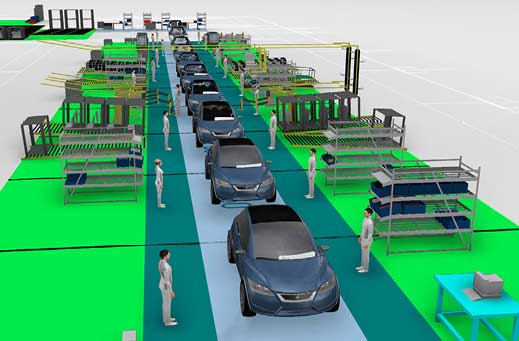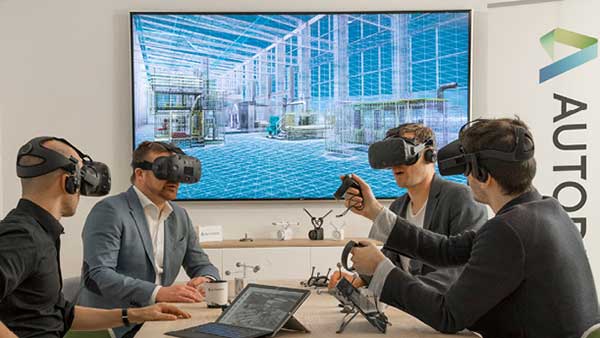Factory Digital Twins Enhance Worker Safety and Supply Chains
How plant simulation and modeling technologies help enforce social distancing and safety practices.

Automotive factory operations, as simulated in Dassault Systèmes’ DELMIA software. Image courtesy of Dassault Systèmes.
Latest News
October 30, 2020
In September, the analyst firm Tech-Clarity published the outcomes of its survey, titled “Business Sustainability and Survival Strategies 2020.” Though the pandemic is certainly on most respondents’ minds, the survey points out “disruption could also apply to other world events such as earthquakes, tsunamis, volcanic activity, hurricanes, and human-created events like terrorism or armed conflict.”
The survey reveals “almost one-half of businesses (46%) have increased focus and/or accelerated digital transformation due to the pandemic.”
“I’ve spoken to a few companies that modeled their factories to figure out how to put people back to work safely—specifically, to figure out how to practice social distancing, or to implement air quality control,” says Julie Fraser, VP of manufacturing software research at Tech-Clarity.
Although quick fixes, such as installing plexiglass barriers and routine temperature checks, will likely go away as the pandemic’s threat fades, other types of supply chain disruptions, natural disasters and warfare are sadly a fact of life; they always have been. Therefore, the use of simulation, digital twins and sensor-driven monitoring to address those disruptions is expected to draw more attention.
“Digital twins of factories and simulation technologies enable companies to better understand the restart requirements and interdependencies,” observes Fraser, “so they can respond better as issues and restrictions change.”
Humans and Facilities
The simplest way to track and enforce social distancing in a factory or a plant might be through wrist-worn devices. Equipped with Bluetooth technology, they run on low energy and can buzz when two devices come within a close range, indicating that the individuals wearing them may be violating the required 6-ft. distancing rule.
Aside from device cost, they require no complicated infrastructure. But they also have many shortcomings, according to Adrian Jennings, VP of real-time location systems at Ubisense.
“For example, when people are turning their backs toward each other, the devices may overestimate the distance between them. Their signals could be blocked by human bodies. And [the devices] don’t recognize barriers, like walls,” he observes.
When two people are standing 3 feet apart with a wall between them, the barrier prevents pathogen transmission. But the wrist-worn devices may still trigger a warning buzz due to their proximity violation.
Jennings believes monitoring efforts need to encompass both human-centric and facility-centric measures. Doing one at the exclusion of the other undermines all efforts.
“On the people-centric side, you help people understand whether their behavior is causing a risk, and warn them when they are too close to each other and when too many of them are occupying the same space,” he explains.
“On the facility-centric side, you need to understand how and if the building or the processes are creating risks. If two employees share the same tool or workspace, they may never come in contact with each other but they still risk passing infection,” Jennings adds.
For the facility-centric view, a 3D model of the environment is crucial. “The building is itself a thing that helps people maintain social distancing, so you need the context of the building,” he says. But the detailed CAD file may first need to be stripped down to barebones geometry to be efficient.
Jennings believes technology’s role is indispensable in the new normal. “No supervisor can supervise that many people 24/7. But computers have infinite attention span so they can monitor people’s movements 24/7,” he says.
Ubisense relies on people to carry ultra-wideband radiofrequency identification tags. These offer precise location data, making them a better choice for closeness and separation monitoring in the pandemic, according to Jennings.
The company offers SmartSpace software and Dimension4 sensors, which serve as the basis for its Real-Time Location Systems (RTLS). Jennings is not surprised to be getting inquiries from engineering firms during the pandemic, but he noticed the company is now also drawing interest from cosmetic producers, food producers and even culinary training schools, which suggests that new markets are opening up.
Different Strokes for Different Folks
RTLS customers are typically large enterprises. “Larger facilities with complex processes benefit the most from RTLS. In smaller companies with simpler workflows, it’s easier to manage separation by policy and process,” Jennings says.
“In my experience, companies that use and benefit from digital twins of factories are usually large companies,” Tech-Clarity’s Fraser also observes. “In a small company, processes are pretty straightforward, and people know one another’s history. In a big company, the same camaraderie doesn’t exist, and they have more complexity when changeover happens.”
One of the headaches for digital twin implementation at the factory or plant level, Fraser points out, is data incompatibility. Newer equipment tends to come with onboard sensors, easy connectivity and monitoring software. Legacy machines don’t have the same setup, thus must be retrofitted for Internet-of-Things-style monitoring. Synchronizing the two equipment types to get a clear picture of the plant’s operations as a whole is no small feat.
“A company also has to deal with various manufacturing execution systems [MES], schedulers, maintenance and quality assurance (QA) systems. These don’t necessarily talk to each other, but they all have data that the digital twin needs,” she notes.
In theory, industries such as automotive and aerospace are much further ahead than others in digital transformation, thus are better positioned to take advantage of digital twins to deal with the fallouts from the pandemic, but Fraser isn’t so sure.
“They tend to have digital twins of products [for example, digital models of the latest Audi or a new jet engine], but in terms of full-scale plant-level digital twins, process and plant industries are in much better shape, because they usually work with a centralized control system,” Fraser reasons.
Catalysts for Digital Twins
Eric Green, VP and managing director for DELMIA at Dassault Systèmes, calls the pandemic another catalyst driving people to adopt more digital modeling and simulation tools. The need to enforce social distancing, install safety barriers on-site and analyze airflows to minimize pathogen transmission are among the top reasons, he observes.

“Some of our customers are trying to figure out how to reconfigure their factories, or add capacity, so they can produce personal protective equipment on-site rather than source them from elsewhere,” Green says.
Even before the pandemic, the tariff war, political upheavals and natural disasters have already exposed the fragility of supply chains, and prompted many manufacturers to rethink their workflows. New trends, such as near-shoring and onshoring, are reversing the processes and practices of offshoring.
Therefore, manufacturers now need to find ways to juggle production across different geographies: for example, adding production capacity to the U.S. site to make up for the Asia site that needs to shut down indefinitely.
“People are using our simulation technologies to figure out how to change their factory layout to add another machine, or a new product mix,” Green says. “Most firms don’t really have idle assets or unused space in their locations. And when you shift production to a new geography, you still need to address social distancing as required by the local agencies, and ensure quality control, so it goes beyond space modeling and allocation. The simulation and modeling get very complex.”
Companies that have mature, well-established digital technologies are able to take advantage of augmented reality and virtual reality (AR/VR) technologies to reconfigure their operations, he notes.
“There are situations where you can solve problems by conducting a virtual walkthrough of the factory to understand what’s happening,” he says, “but it depends on the maturity level of the company.”
High Variability, Low Volume
Companies with two main characteristics seem to benefit more from factory and plant simulation technologies.
“This might be a gross generalization but in discrete manufacturing, high variability and low volume tend to be the key [characteristics],” says Srinath Jonnalagadda, VP of strategy, design and manufacturing, Autodesk. “They require a lot of configurability and dynamism.”

The use of AR/VR to remotely monitor and analyze factory operations and space allocation is one way to meet the social-distancing requirements for the restart. Image courtesy of Autodesk.
The basic needs for factory simulation remain the same: “This is nothing new: Manage the configurations of the factory. Manage the flow of operations. Streamline the path of the work. Reconfigure the factory layout based on whatever new demand comes up,” observes Jonnalagadda. But the pandemic adds extra burdens on top of these requirements.
“Now you also need new processes and tools to keep the staff safe, manage risks while maintaining business continuity, maintain a line of sight and make sure the plant is ready to react and respond to shocks from the supply chain,” he says.
With the pandemic and travel restrictions, many factory and plant operators are finding that physical access to the site is severely limited. “So they’re looking to keep the productivity at pre-pandemic level while observing the factory operations remotely,” notes Jonnalagadda.
Autodesk offers Factory Design Utilities, described as a set of software tools to plan, design and install an efficient factory layout. It’s part of the Product Design & Manufacturing Collection, integrated with Inventor, AutoCAD, Navisworks and other Autodesk titles.
BASF found an efficient way to inspect its facilities using AR/VR. “They recently came to us and asked for a way to combine our technology with HoloLens, so that they can use the digital model of the factory and plant in situ onsite, so the maintenance workers can do inspections in HoloLens, compare it to the design model to identify problems and suggest repairs,” says Jonnalagadda.
On the use of AR/VR, Fraser cautions, “Most people don’t want to wear goggles all day, so the key is to identify the right use case and strategically deploy them.”
The use of AR/VR for remote expert, as exemplified by BASF’s case, can help minimize contact. On the other hand, for on-site deployment of AR/VR, the need to sanitize shared goggles is an important factor during the COVID era.
More Autodesk Coverage
More Dassault Systemes Coverage

Subscribe to our FREE magazine, FREE email newsletters or both!
Latest News
About the Author
Kenneth Wong is Digital Engineering’s resident blogger and senior editor. Email him at [email protected] or share your thoughts on this article at digitaleng.news/facebook.
Follow DE







